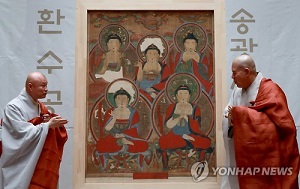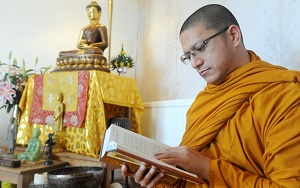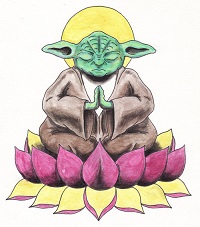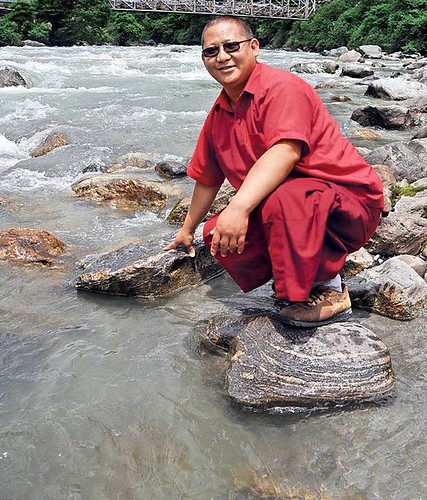Dharma companions is a blog focusing on Dharma activities, information dissemination and bringing awareness to the multifaceted aspects of Buddhism for the community from Shah Alam Buddhist Society (SABS). Postings should be of interest to Buddhist and anyone who seeks information on Buddhism. As the title suggest, we also aim to be a companion to those who seeks our company in this path that we undertake. May you be well, happy and peaceful.
Saturday, December 31, 2016
‘Many errors about Buddhism in Ahmad Iqram’s book’
- Rahula Thor Published 26 Dec 2016

I refer to the book, ‘Yahudi, Kristian, Hindu dan Buddha berasal daripada Islam?’ by Ahmad Iqram Mohamad Noor, Chapter 7 (Agama Buddha Berasal Daripada Islam). There are too many mistakes. Suffice to mention a few here:
Location:
Malaysia
Attainment of Sukha with Sukha 《以樂證得樂》
Another thing I want to share with all of you: Nowadays teachers in many countries, in many centres teaching the Dhamma, instruct the meditators to pay attention to the pain arising in the body and to observe it, labelling it as ‘pain... pain...pain’. I believe all of you have practised this way in the past. I have also practised in this way. I tried until I overcame the pain.
另外,我有一點想與大家分享。現今世界各地,有不少的導師在許多國家的禪修中心教導法;指導禪修者,去注意與觀察他們體內產生的各種痛苦的覺受,並將之標示為~痛苦、痛苦、痛苦。我相信,你們也經歷過類似的修行方法。我本人也是透過這方法修行,直到克服了那種痛苦。
另外,我有一點想與大家分享。現今世界各地,有不少的導師在許多國家的禪修中心教導法;指導禪修者,去注意與觀察他們體內產生的各種痛苦的覺受,並將之標示為~痛苦、痛苦、痛苦。我相信,你們也經歷過類似的修行方法。我本人也是透過這方法修行,直到克服了那種痛苦。
Labels:
Teacher,
Understanding
Location:
Shah Alam, Selangor, Malaysia
Friday, December 30, 2016
Going to Meet the Five Ascetics 《去見五位苦行者》
After the bodhisatta had attained Full Enlightenment and become a Buddha, He spent seven days each in seven places – forty-nine days altogether. After that, He proceeded on His journey to the Isipatana Migadāya forest of Bārāṇasi. Why did the Buddha go there? To teach the Dhamma to the five ascetics who had been his attendants while he was engaged in austerity practices for six years. 菩薩圓滿證悟成為佛陀後,他(在菩提樹附近)待了四十九天,在七個地方,各待七天。之後,他前往巴拉納西(Bārāṇasi)仙人落處(Isipatana)的鹿野苑。 為什麼佛陀要去那兒呢?因為他要去給跟隨他苦行六年的五位苦行者說法。
Labels:
Teacher,
Understanding
Location:
Shah Alam, Selangor, Malaysia
Theragatha 1.118
Labels:
Understanding
Location:
Shah Alam, Selangor, Malaysia
A Handful of Pain, by Diana St Ruth
Posted on 9 February 2014 by Buddhism Now
 Anguishing about what we have or have not got can often be a far greater suffering than physical pain. The anguishing might be related to physical pain ― we don’t want it ― but the dread and despair we suffer are not themselves physical pain. We pile anguish on top of pain by longing for it to go. Desire first, then the impatience and anguishing . . . and then desire again, going round and round ― cause and effect.
Anguishing about what we have or have not got can often be a far greater suffering than physical pain. The anguishing might be related to physical pain ― we don’t want it ― but the dread and despair we suffer are not themselves physical pain. We pile anguish on top of pain by longing for it to go. Desire first, then the impatience and anguishing . . . and then desire again, going round and round ― cause and effect.
Labels:
Teacher,
Understanding
Location:
United States
How to grow good qualities
Labels:
Teacher,
Understanding
Location:
Shah Alam, Selangor, Malaysia
Thursday, December 29, 2016
Renewing the joy of encountering the other this festive season
By Buddhistdoor Buddhistdoor Global 2016-12-23
 From wpp.com
From wpp.com
By now, many of us will have seen the familiar Christmas images in advertisements, on billboards, and behind the glass windows of shops. The scenes invoke a cozy warmth and merry conversation, from the fireplace before which couples snuggle to the dinner table around which family members gather, or the snowy town square where old friends catch up. These motifs all share the common theme of encounter, of old and new meetings alike. It is through new or renewed encounters that our world expands, our horizons broaden, and our context deepens into new textures and layers that would never have been discerned had we not met that new “Other.”
The Heightened Mind
The Buddha’s path consists of three trainings: training in heightened virtue; in heightened mind, or concentration; and in heightened discernment. Although all three are essential for Awakening, the Buddha often singled out the second training for special attention. Ajaan Lee does the same in the talks translated here. As he once said, the three trainings are like posts supporting a bridge over a river. The posts on the near shore and far—virtue and discernment—are not that hard to set in place, for they lie in shallow water away from the main current of the river. The posts in the middle of the river— concentration—are the ones requiring special effort, and so they need to be treated in depth.
Labels:
Teacher,
Understanding
Location:
Shah Alam, Selangor, Malaysia
The winning image
- More than 500 images were entered into The Society of International Travel and Tourism's photo contest. The winning image captures a Buddhist monk being paddled across a river in Bangladesh in morning mist
- By Naomi Leach For Mailonline PUBLISHED: 21 December 2016
The winning shot in The Society of International Travel and Tourism Photographers' 'My Voyage of Discovery' competition was taken by Jewel Chakma from Rangamati, Bangladesh. It depicts a Buddhist monk going to collect food from a village in a boat on the Rangkong River. Chakma said: 'The monk goes to collect food from villagers, which we call Pindusoron. This is a system monks use to get fed'

Wednesday, December 28, 2016
Theragatha 2.2
Labels:
Understanding
Location:
Shah Alam, Selangor, Malaysia
The Tree in the Seed
Samadhi is firm concentration. If you’re firm in your practice, it’s a kind of concentration, but it doesn’t yet give you the fruit. It’s still just the flower—but out of the flower comes the fruit, big or small. The potentials of people are not the same. Things that are buried inside, we don’t yet see. Like the seed of a jackfruit: Suppose that you eat some jackfruit and lift out a seed. When you do that, you’re lifting a whole jackfruit tree, but at the moment, you don’t see it. You don’t yet know it. Even if you were to split open the seed, you still wouldn’t see the tree because it’s subtle.
Labels:
Teacher,
Understanding
Location:
Shah Alam, Selangor, Malaysia
Tuesday, December 27, 2016
Tusita heaven
Labels:
Understanding
Location:
Shah Alam, Selangor, Malaysia
Stolen Buddhist painting returns to S. Korea from U.S.
Yonhap News, Dec 14, 2016SEOUL, South Korea -- The Jogye Order, South Korea's largest Buddhist sect, on Wednesday revealed an 18th-century stolen Korean Buddhist painting returned from the United States after its American owner and a U.S. art museum agreed to repatriate it here.  The Buddhist painting "Obuldo," meaning five Buddhas, is uncloaked at the office of the Jogye Order of Korean Buddhism in Seoul on Dec. 14, 2016. The painting was stolen from Songgwang Temple in Suncheon, 415 kilometers south of the capital, and later turned up at the Portland Museum of Art in the United States, donated there by American Robert Matielli, who had purchased it in Seoul. It was brought back to Korea on an agreement by Matielli and the museum. At left is Ven. Jinwha, head of Songgwang Temple, and at right is Ven. Jaseung, head of the Jogye Order, the largest Buddhist sect in Korea. (Yonhap) The Buddhist painting "Obuldo," meaning five Buddhas, is uncloaked at the office of the Jogye Order of Korean Buddhism in Seoul on Dec. 14, 2016. The painting was stolen from Songgwang Temple in Suncheon, 415 kilometers south of the capital, and later turned up at the Portland Museum of Art in the United States, donated there by American Robert Matielli, who had purchased it in Seoul. It was brought back to Korea on an agreement by Matielli and the museum. At left is Ven. Jinwha, head of Songgwang Temple, and at right is Ven. Jaseung, head of the Jogye Order, the largest Buddhist sect in Korea. (Yonhap) |
Buddhists welcome promotion of Phra Payutto
The Bangkok Post, 11 Dec 2016
Outsider is highly regarded for his contribution to Buddhism
Bangkok, Thailand -- His Majesty the King presided over an annual ceremony on Monday to promote senior Buddhist monks in the cleric ranking system.
.jpg) << Phra Prayudh Payutto has been promoted.
<< Phra Prayudh Payutto has been promoted.Among the 159 promoted monks, Venerable Bhikkhu P A Payutto received the title Somdej Phraracha Khana, the second-highest position after Supreme Patriarch in the ecclesiastical nine-tiered hierarchy.
Speaking to his followers after the appointment on the late King Bhumibol Adulyadej's birthday, Bhikkhu P A Payutto told his followers to feel grateful to the late King Rama IX for his contribution to Buddhism.
He also said humbly that much of the work to promote Buddhism at the temple came from his Buddhist followers as he has not done much in recent years due to his poor health. He told people to treat him the same way they always had.
Widely called Phra Prayudh Payutto, his appointment was unexpected. "Phra Maha Prayudh Payutto was an outsider from the administration of the monks' governing body, even though he is widely respected and revered for his discipline and intelligence," said Phra Palad Wisarut Thirasaddho, a monk from Wat Thumkaocha-ang Temple in Kanchanaburi who formed a network of progressive monks on Facebook.
Labels:
Announcement,
Location,
Skillful Practice,
Teacher
Location:
Thailand
Monday, December 26, 2016
Donating Dhrama
 A mp3 player with dramna files
A mp3 player with dramna files
December 20, 2016 01:00 By PARINYAPORN PAJEE THE NATION
A group of generous volunteers is distributing mp3 sets with audio files of prayers and mantras to the sick and underprivileged
Dhrama texts have long been known to soothe the minds and spirits of the sick, whether they are bedridden, in palliative care or terminally ill and nearing death. For those who are in severe pain, physically reading the texts is often not an option. Caregivers can help out but all too often do not have the time. Now, though, help is here through the advent of dharma audio books.
The initiative, known has Wittayu Boon (literally merit radio) consists of a pocket mp3 radio player containing dozens of dharma audio book files. These are now being distributed to hospitals for use by patients, mostly on palliative care or ICU wards, on a loan basis at no charge.
North-east Buddhist retreat backed by planners
by Ryan Cryle, Evening Express, 17 Dec 2016
 Varapunya Meditation Centre submitted plans to Aberdeenshire Council to change a residential property into a place for Buddhist teachings.
Varapunya Meditation Centre submitted plans to Aberdeenshire Council to change a residential property into a place for Buddhist teachings.Planned by Venerable Sujan, the new base, at Easter Mains Cottage between Kingswells and Westhill, will include ancillary woodland,a meditation garden and two summer houses.
Labels:
Location,
Skillful Practice
Location:
Aberdeen, UK
Harvard Has a Free Online Course on Buddhism That You Can Take Right Now
Labels:
Announcement,
Skillful Practice,
Teacher
Location:
United States
Sunday, December 25, 2016
"If we cling to anything in this world we would be consumed by stress, sorrow and pain”

“…The Buddha exhorts us to calm our mind as the first priority because when the mind is restless and agitated it is confused, it can’t tell north from south, cause from effect, right from wrong, good from bad, pain from pleasure; it is deluded, not seeing things clearly as they are, such as seeing pleasure in sensual gratification when in fact it’s miserable and painful.
Labels:
Teacher,
Understanding
Location:
Shah Alam, Selangor, Malaysia
Buddhist lessons from Star Wars
by Henna Achhpal, DNA India, 12 Dec 2016
New Delhi, India -- The world’s most loved sci-fi saga has religion at its core, borrowing themes from several Buddhist principles and concepts
 Star Wars can be a religion in itself. Not only because of its global cult like following, or the inspired significant dates and phrases, but also owing to the several underlying spiritual themes packed in the action adventure saga. It’s no co-incidence as the creator, George Lucas, specifically intended to deal with religious issues.
Star Wars can be a religion in itself. Not only because of its global cult like following, or the inspired significant dates and phrases, but also owing to the several underlying spiritual themes packed in the action adventure saga. It’s no co-incidence as the creator, George Lucas, specifically intended to deal with religious issues.Lucas had been mulling over questions relating to religion from a young age and the making of Star Wars was a way to bring some of them to a conclusion. In an interview from 1999 he said, “The conclusion I have come to is that all of the religions are true; they just see a different part of the elephant. Religion is basically a container for faith. Faith is the glue that holds us together as a society. It is a very important part of allowing us to remain stable - remain balanced.”
Labels:
Skillful Practice
Location:
New Delhi, Delhi, India
Pindapata at Wat Doi Phra Jow Ton Luang
Published on Dec 18, 2016
by Losel Boon Hong Chuah
Sit with your coffee/tea and immersed yourself in this age-old Buddhist tradition.
https://www.youtube.com/watch?v=bEPvb49KpfE
by Losel Boon Hong Chuah
Sit with your coffee/tea and immersed yourself in this age-old Buddhist tradition.
https://www.youtube.com/watch?v=bEPvb49KpfE
Labels:
Inspirational,
Skillful Practice,
Video
Location:
Thailand
Official launching Ceremony of Malaysia Buddhist Consultative Council (MBCC)
 Committee members representing the six components of Malaysian Buddhist Consultative Council at the Official Launch of MBCC on Sunday 18/12/16.
Committee members representing the six components of Malaysian Buddhist Consultative Council at the Official Launch of MBCC on Sunday 18/12/16. The Official Launching Ceremony of Pertubuhan Perundingan Buddhis Malaysia
马来西亚佛教咨询理事会Malaysian Buddhist Consultative Council on 18 December 2016.
Labels:
Announcement,
Inspirational,
Skillful Practice
Location:
Malaysia
Saturday, December 24, 2016
Buddhist monks embracing the spirit of Christmas
by Dave Stewart, The Guardian.pe, December 17, 2016LITTLE SANDS, P.E.I. (Canada) -- P.E.I. Buddhist monks and nuns don’t observe Christmas, but they are still making plans to don their Santa hats.  The Great Enlightenment Buddhist Institute Society (GEBIS) and the Great Wisdom Buddhist Institute (GWBI) both plan on embracing the spirit of giving as a way to thank Islanders for all their generosity. The Great Enlightenment Buddhist Institute Society (GEBIS) and the Great Wisdom Buddhist Institute (GWBI) both plan on embracing the spirit of giving as a way to thank Islanders for all their generosity.The GEBIS monks have been on the Island for the past seven years while the GWBI nuns have been here for the past four years. |
Bridging Buddhism & Science, Emory Tibet Symposium, Day One
EIN News, Dec 18, 2016
Mundgod, Karnataka (India) -- Today, His Holiness the Dalai Lama elected to walk the relatively short distance between Drepung Lachi and Drepung Loseling. He greeted well-wishers along the way, as well as offering comfort to beggars who also vied for his attention. In the spacious Loseling assembly hall approximately 3000 monks, 260 nuns - including the 20 new Geshe-mas - local Tibetan school-children, and people from abroad were gathered to attend the first international Emory Tibet Symposium. |
The Alms-bowl of a Theravada monk

The monk’s alms-bowl is only used to receive cooked food & fruits offered by willing donors. The monk strictly does not accept money with his bowl or on his Pindacāra (alms-round).
Labels:
Teacher,
Understanding
Location:
Shah Alam, Selangor, Malaysia
Friday, December 23, 2016
Importance of Calm Abiding ~ 17th Karmapa
We cannot immediately grasp the more advanced practices, such as the Great Seal (mahamudra) or the Great Completion (mahasandhi), both of which lead to the result of primordial wisdom. For all of these higher-level practices, we need a steady basis, which is none other than the correct practice of calm abiding. If the untamed mind is filled with concepts and afflictions, these higher practices are not possible. In the beginning, a tree needs strong roots. Similarly, what is most important for meditation is calm abiding. – 17th Karmapa
from the book "Music In The Sky: The Life, Art, And Teachings Of The 17Th Karmapa Ogyen Trinley Dorje"
translated by Michele Martin
Labels:
Teacher,
Understanding
Location:
Shah Alam, Selangor, Malaysia
Buddhist Monk Wins Wildlife Service Award
By Jnan Nanda Buddhistdoor Global 2016-12-15  Lama Lobsang Gyatso. From indiatoday.intoday.in
Lama Lobsang Gyatso. From indiatoday.intoday.in
Lama Lobsang Gyatso, a Tibetan Buddhist monk who has been a vocal opponent of hydropower projects in Tawang District of the northeastern Indian state of Arunachal Pradesh, has received the Sanctuary Wildlife Service Award from Sanctuary Asia magazine in recognition of his untiring campaign to save the region’s population of black-necked cranes.
Labels:
Inspirational,
Skillful Practice
Location:
Tawang
At Home in the World, by Thich Nhat Hanh
Posted on 16 December 2016 by Buddhism Now
 The tradition of Zen teaching stories goes back at least to the time of the Buddha. Like the Buddha, Thich Nhat Hanh uses story–telling to engage people’s interest so he can share important teachings, insights and life lessons.
The tradition of Zen teaching stories goes back at least to the time of the Buddha. Like the Buddha, Thich Nhat Hanh uses story–telling to engage people’s interest so he can share important teachings, insights and life lessons.
Drawing of the Buddha
When I was a small boy of seven or eight I happened to see a drawing of the Buddha on the cover of a Buddhist magazine. The Buddha was sitting on the grass, very peacefully, and I was impressed. I thought the artist must have had a lot of peace and calm within himself at the time to be able to draw such a special image. Just looking at the drawing made me happy, because so many people around me at the time were not very calm or happy at all.
Thursday, December 22, 2016
Metta— Ajahn Sundara, Walking the World
Labels:
Understanding
Location:
Shah Alam, Selangor, Malaysia
Nobody Likes Being Disturbed, by Buddhadasa Bhikkhu
Posted on 16 November 2016 by Buddhism Now
 We must first be aware of these two categories, ’empty of I’ and ‘not empty of I’. The former is called ’empty’ and the latter is called ‘disturbed’ and to save time that is how they will be referred to from now on.
We must first be aware of these two categories, ’empty of I’ and ‘not empty of I’. The former is called ’empty’ and the latter is called ‘disturbed’ and to save time that is how they will be referred to from now on.
Here your common sense may say straight away that nobody likes being disturbed. If I were to ask those people who like being disturbed to raise their hands, if anyone did so it would have to be a joke. Everyone likes to be empty in one way or another. Some people like the lazy emptiness of not having to work. Everyone likes to be empty of annoyance, not having the kids coming to bother you. But that emptiness is an external thing, it is not yet true emptiness.
The Story of Li Ka Shing
Very inspiring. He said that Buddhism has a role in bringing happiness to his life. He also applied Confucian thinking in his business management while adopting a Western Business Management Model.
The interview was in Cantonese Language with English subtitle.
https://www.facebook.com/GentlemanMY/videos/1093075634073356/
Subscribe to:
Posts (Atom)































